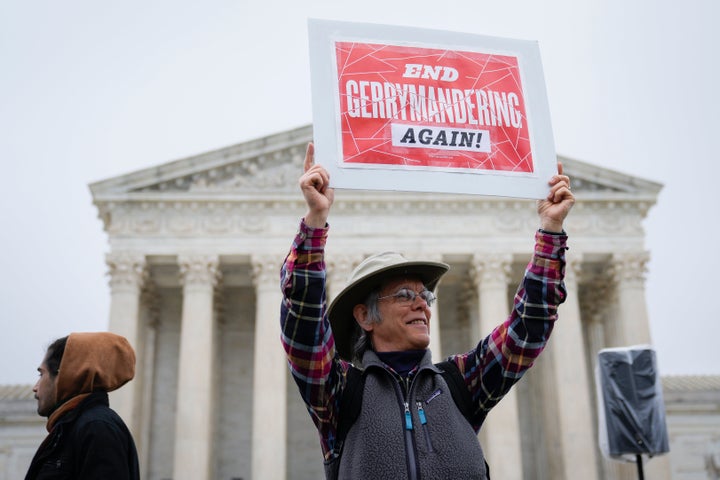In a surprise decision, the Supreme Court agreed that Alabama violated the Voting Rights Act by diluting the Black vote when it drew new congressional maps following the 2020 census.
The 5-4 decision written by Chief Justice John Roberts found that Alabama Republicans improperly denied Black communities a second congressional district by packing them into one district and splitting them into other majority white districts. The decision was joined by liberal Justices Elena Kagan, Sonia Sotomayor and Ketanji Brown Jackson and conservative Justice Brett Kavanaugh.
The decision in Allen v. Milligan comes as a shock as the court’s conservatives have repeatedly gutted the Voting Rights Act in cases over the past decade including Shelby County v. Holder and Brnovich v. Democratic National Committee.
In his decision, Roberts firmly rejected Alabama’s arguments in favor of a new race-neutral standard to govern racial gerrymandering cases brought under Section 2 of the Voting Rights Act as “novel.”
“The heart of these cases is not about the law as it exists,” Roberts wrote. “It is about Alabama’s attempt to remake our [Section 2] jurisprudence anew.”
Alabama will now be required to redraw its congressional district map to provide for a second majority-Black district. The decision will have extended consequences too as both plaintiffs in Louisiana and Georgia claimed similar racial discrimination in redistricting in cases that were pending at the Supreme Court. This could lead to the creation of one new Black-majority district in each state.
The case came about after Alabama Republicans, who dominate the state’s politics, drew a new congressional district map that cracked the Black community across the historic Black Belt (named for its soil), splitting the predominantly Black city of Montgomery into three majority-white congressional districts while packing the rest of the state’s Black community into the 7th District.

Since Black people make up 27% of the state’s population, this map appeared to dilute the Black vote by not drawing a second Black-majority district. Black Alabamians, the Alabama chapter of the NAACP and Greater Birmingham Ministries filed a lawsuit alleging that the map violated Section 2 of the 1965 Voting Rights Act by not creating a second district where Black voters could elect someone who represented their interests.
A federal district court agreed with these plaintiffs by turning to Supreme Court precedent in the 1986 case of Thornburg v. Gingles. In Gingles, the court laid out a framework to govern how courts should judge Section 2 racial vote dilution cases. This framework demanded that Section 2 racial vote dilution cases meet three tests to prove that an additional majority-minority seat is warranted.
That test required plaintiffs to show that the minority population is, first, sufficiently large and geographically compact; second, politically cohesive, in that they vote as a bloc; and third, that the majority and minority populations are politically polarized.
The district court found that the Alabama case met all of these tests in the Gingles framework.
The state of Alabama appealed, arguing that the courts should overturn the Gingles precedent and affirm a new standard that judges Voting Rights Act cases on a race-neutral basis. This race-neutral approach would draw district maps by taking the average district lines created in a series of algorithmically drawn maps that did not account for race.
Roberts rejected these arguments and affirmed the court’s prior precedent in Gingles. In doing so, he stated that the district court’s decision showing that Alabama’s map violated Section 2 of the Voting Rights Act was correct.
“The contention that mapmakers must be entirely ‘blind’ to race has no footing in our [Section 2] case law,” Roberts wrote.
The state also argued that the court should stop hearing Section 2 racial gerrymandering cases altogether by claiming both that the Voting Rights Act does not apply to single-member districts and also that the 15th Amendment forbids “race-based redistricting.” Roberts rejected both of these arguments as opposing the court’s decades-long precedent.
In upholding the court’s precedent in Gingles, Roberts recounted the history of how a bipartisan law passed by Congress in 1982 forced the court to accept the use of non-explicit racial discrimination in Section 2 cases.
In 1980, the court ruled in City of Mobile v. Bolden that racial gerrymandering cases brought under Section 2 could only succeed if they showed evidence of explicit racial discrimination. The decision provoked a political firestorm and Congress eventually enacted a law overriding the court by stating that Section 2 cases can succeed if they show a disparate negative impact, rather than just explicit racism. The court then revised its Section 2 jurisprudence in Gingles.
What makes Thursday’s decision in Allen v. Milligan so surprising is that Roberts, a staffer in Ronald Reagan’s Department of Justice, fiercely opposed the 1982 law that overrode the court’s opinion in City of Mobile. He counseled Reagan to oppose the law as it moved through Congress.
But today he affirmed Congress’ intent in that 1982 law and rejected an attempt to overturn the Gingles precedent interpreting it.
The dissenters — Justices Clarence Thomas, Samuel Alito, Neil Gorsuch and Amy Coney Barrett — would have it the other way. Thomas, in a solo dissent, reiterated his fierce opposition to the court’s “long-deplorable” precedents on Section 2 racial vote-dilution gerrymandering cases.
“At the outset, I would resolve these cases in a way that would not require the Federal Judiciary to decide the correct racial apportionment of Alabama’s congressional seats,” Thomas wrote.
But the court did not follow Thomas’ lead to overturn Gingles. While the decision is a rare win for voting rights advocates, the court did allow Alabama to use this illegal map in the 2022 election. And it breaks no new ground in expanding voting rights. For this conservative court, though, maintaining precedent can be considered a victory.

